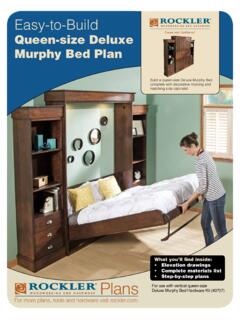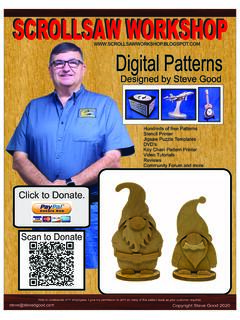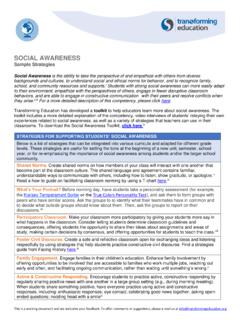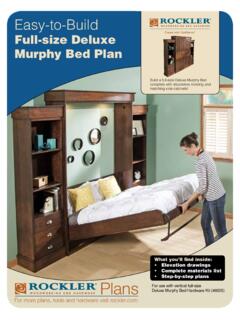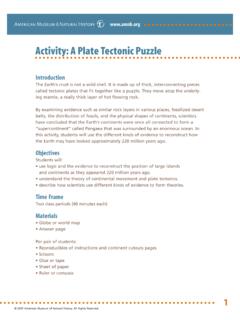Transcription of Classroom Accommodations Checklist
1 Classroom Accommodations Checklist Handout Adapted from Accommodations : Assisting Students with Disabilities T-3. A Guide for Educators A. INSTRUCTIONAL METHODS AND MATERIALS. 1 . Student can't identify main ideas or important points. q Highlight important points of the text to draw attention. Tell the student to read these points first. q Give the student a list of important vocabulary. q Have the student read the summary or objectives first. q Have the student read the review questions first, then look for the answers. q Give the student a worksheet or study guide to follow when he or she must do independent reading. q Use hands-on activities, pictures, or diagrams to support understanding of abstract concepts or complex information. q Let the student use sticky notes or an erasable highlighter to mark key points in the textbook.
2 Q Let the student use a book written at a lower grade level. This can help the student pay more attention to the main ideas. 2 . Student can understand the information, but can't read the required materials. q Provide an audio version of the material. Use books-on-tape or have an assistant, volunteer, or other student make a recording. q Use a videotape or movie that presents the same information. q Use assistive technology to transfer printed words to speech. q Have a learning buddy read aloud textbooks or other printed material. 3 . Student is blind or visually impaired. q Provide books-on-tape or large print versions of text. q Provide books and other instructional materials in braille. q Provide copies of class handouts and materials with key information in an embossed format.
3 Q Provide a special tilt-top desk or book stand to hold materials for easier reading. q Provide specialized equipment, such as an optical enhancer, magnifier, tape recorder, stylus and slate, or braillewriter. q Talk while you teach, making an attempt to describe exactly what you are doing. Be sure to describe nonverbal messages and introduce beginnings, transitions, and closures to each activity. q Use real-life examples and concrete materials whenever possible. q Make the student feel comfortable asking for assistance. Tell me what you need. How does this fit with what you know? . 4 . Student is deaf or hard-of-hearing. q Make sure the student is facing you when you are speaking. q Seat the student in the place where he or she can receive maximum information and is least likely to be distracted by other Classroom activities.
4 Dealing with Differences: Strategies That Work! Page 1 of 9. Classroom Accommodations Checklist Adapted from Accommodations : Assisting Students with Disabilities . A Guide for Educators 4 . Student is deaf or hard-of-hearing. (cont'd). q Use nonverbal communications to convey your messages. q Use visual information (words, charts, graphics) to reinforce what is presented orally. Repeat as often as necessary. q Help the student to be comfortable asking others for assistance whenever it is needed. Tell me what you need.. q Use a sign language interpreter or notetaker when appropriate. 5 . Student has difficulty with most lessons. 5 a . Student needs help to get ready for the lesson q Introduce new vocabulary prior to lesson; prepare a glossary of terms; use visual aids (chalkboard, overhead, charts).
5 Q Use advance organizers to alert students to what will be included and expected from the lesson or discussion. q Provide an overview of the content or expected learning at the beginning of the session. q Link what is being learned to previous lessons or background knowledge. 5 b . Student needs help during the lesson. q Present material in a logical manner and use explicit cues to shift from one aspect to the next. q Promote active involvement of students by asking questions or breaking up the lecture with small group interaction, discussion, or structured responses. q Break the information into steps or key components and monitor the student's comprehension as the information is presented. q Provide oral and visual clues during lecture or discussion about what is important to include in notes.
6 Write important ideas on the board or chart paper. Use different color chalk or markers for emphasis or coding. q Provide structured organizers for notetaking, such as a copy of overheads, outline of lecture, or pre-designed graphic organizers. q Provide students with copies of notes taken by peers. q Teach the student how to use a two-column notetaking format or concept mapping for notes. q Key class notes to the relevant pages in the textbook. q Let the student use a tape recorder to record class lectures and discussions. q Repeat, paraphrase, and summarize all important points, particularly at the conclusion of the lecture or discussion. q Ask the student to paraphrase key points in his or her own words and identify anything that is still unclear. q Prepare a summary of important information from the lecture with blanks to be filled or questions to be answered by the student.
7 5c. Student needs help after the lesson. q Use cooperative learning techniques such as Think-Pair-Share or Jigsaw to have students review key points. Dealing with Differences: Strategies That Work! Page 2 of 9. Classroom Accommodations Checklist Handout Adapted from Accommodations : Assisting Students with Disabilities T-3. A Guide for Educators 5c. Student needs help after the lesson. (cont'd). q Ask the student to tell or write the important information that was included in the lesson before the class ends. Encourage the student to ask questions. q Arrange for time to meet with the student after class to clarify anything the student doesn't understand. 6. Student has difficulty with mathematical concepts and processes. q Let the student use concrete materials and manipulatives to explore and learn about mathematical concepts.
8 Q Use computer-based models to represent mathematical concepts. q Let the student practice skills using computer-based instruction. q Let the student use a calculator for routine computation tasks. q Let the student use a chart or table with basic math facts. q Color-code or highlight key words in math word problems. q Let the student use a flowchart to plan strategies for problem solving. B. ASSIGNMENTS AND ASSESSMENTS. 1. Student has difficulty following instructions . 1a. Student needs help to get ready for the instructions . q Use a prearranged signal to gain the student's attention before giving directions. q Make sure the student is facing you when instructions are given. q Change your tone of voice to alert the student and sustain attention. q Give the student an agenda or schedule for each day.
9 1 b . Student needs help while you are giving instructions . q Combine oral directions with pictures, words, or diagrams. q Read written directions orally before starting the assignment. q When modeling expected behavior, describe critical components. q Complete sample problems or tasks to show the student what is expected. q Have the student paraphrase instructions or show you what to do. q Repeat and simplify instructions for the student. q Give the student a description of expected behaviors or the rubric to be used for evaluation. q Give step-by-step instructions with the steps outlined in writing or shown in picture sequences. 1 c . Student needs help after you give the instructions . q Assign a study buddy to help the student when needed. q Check to see if the student needs any assistance in getting started.
10 Q Teach the student how to use an assignment notebook or personal planner to keep track of assignments and work. Dealing with Differences: Strategies That Work! Page 3 of 9. Classroom Accommodations Checklist Handout Adapted from Accommodations : Assisting Students with Disabilities T-3. A Guide for Educators 2. Student has difficulty completing assignments. q Break long-term assignments into parts with corresponding due dates. q Teach the student to maintain a calendar of assignments. q Give the student an individual responsibility Checklist . q Give the student a choice of tasks and assignments. q Let the student have access to learning resources and instructional materials outside of class. q Use a kitchen timer to define work times. q Reduce the total amount of work, but select those tasks or items that are needed to accomplish learning objectives.

